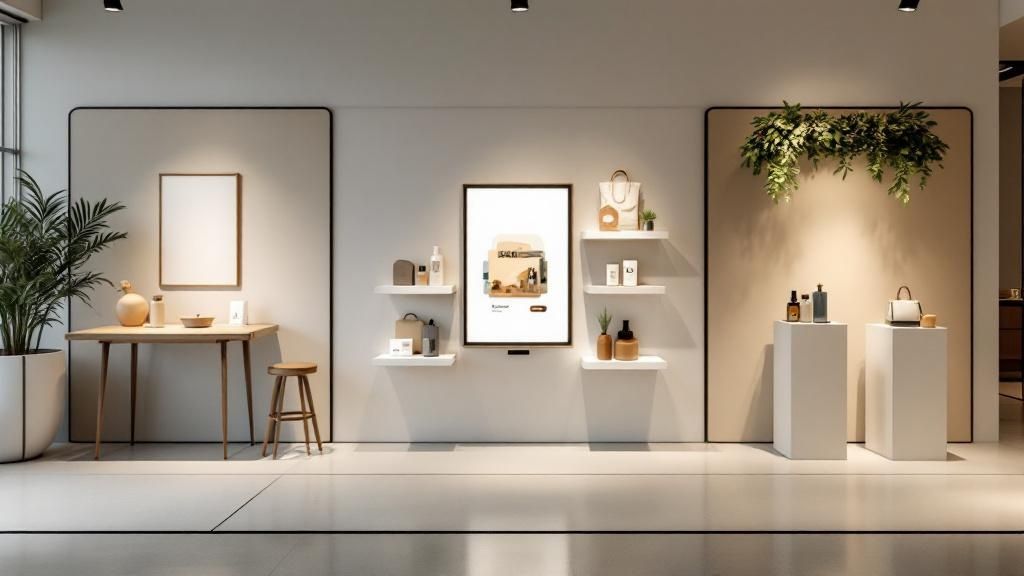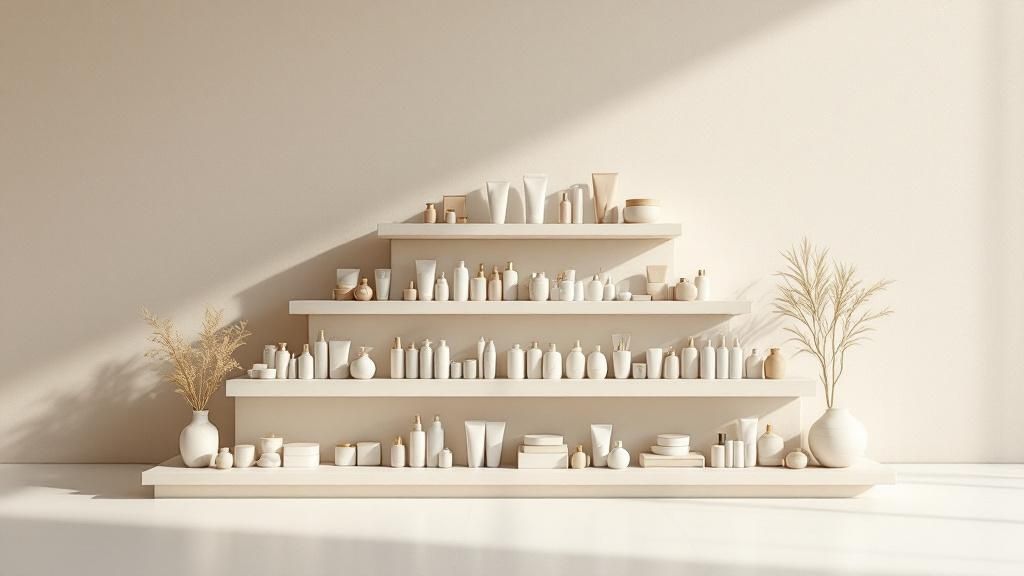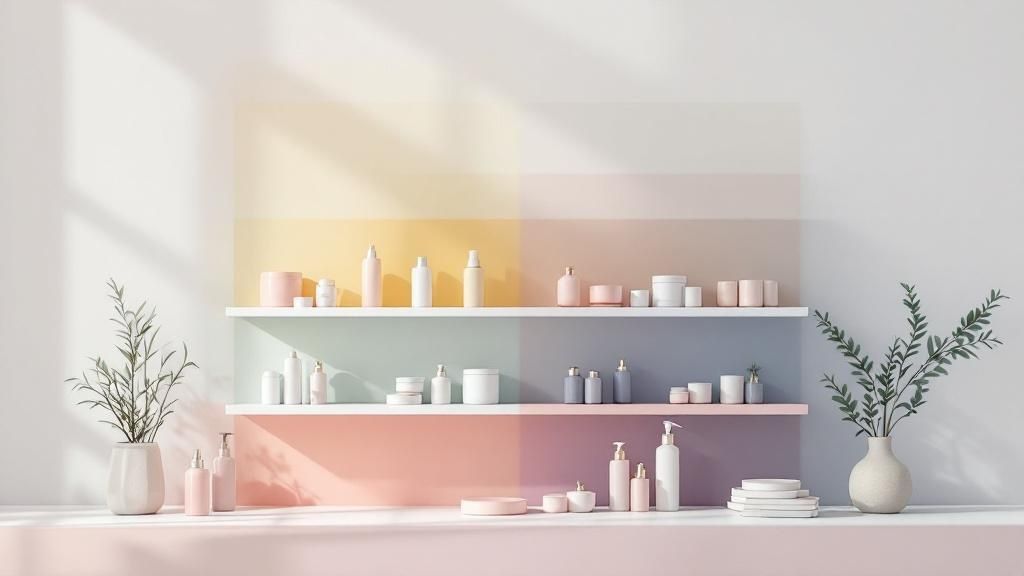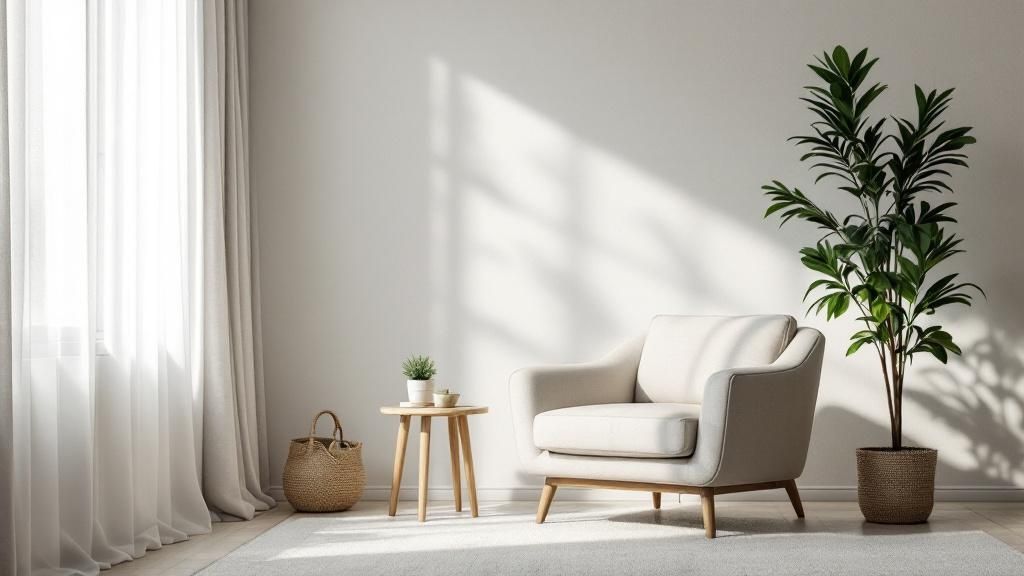Your cart is currently empty.

In the bustling world of retail, capturing a customer's attention is the first step towards making a sale. A well-crafted store display does more than just showcase products; it tells a story, creates an experience, and guides the customer's journey through your space. Effective store display ideas can transform a passive browser into an active buyer, significantly boosting your sales and brand loyalty. This is because a great display acts as your most effective silent salesperson, working around the clock to engage and persuade.
To ensure your displays effectively guide customer attention and communicate value, consider mastering visual hierarchy in design. This principle is fundamental to organising elements in a way that naturally draws the eye to your key products.
This guide explores nine powerful and creative display strategies that move beyond the obvious, offering fresh, actionable insights for businesses of any size. From the timeless psychology of the 'Rule of Three' to the engaging potential of interactive tech, these concepts are designed to captivate, inspire, and convert. We'll provide practical tips, real-world examples, and the know-how to implement these ideas effectively, helping you create a retail environment that truly stands out. Let's dive in.
1. Pyramid Display
The pyramid display is a classic and highly effective retail merchandising technique. It involves arranging products in a triangular or pyramid shape, a geometric form that naturally draws the human eye upward towards a focal point. This structure creates a clear visual hierarchy, allowing you to spotlight a hero product at the peak while using other items to build a stable and attractive base.

This method is one of the most versatile store display ideas because it works across numerous industries. Think of a tower of vibrant, stacked iPhone cases in an electronics shop, a festive pyramid of wine bottles in a grocery store, or a meticulously organised display of best-selling novels in a bookshop. The principle remains the same: guide the customer’s gaze to your most important item.
How to Implement a Pyramid Display
Creating a successful pyramid display requires more than just stacking items. Focus on stability, visual balance, and strategic product placement to maximise its impact.
- Build a Strong Base: Ensure the foundation of your pyramid is wide and sturdy. This not only prevents collapses but also creates a sense of abundance and stability.
- Highlight Key Products: Place your highest-margin or most featured product at the peak or just above eye level. This is the "hero" spot that captures the most attention.
- Use Odd Numbers: Groupings of three, five, or seven items are often more visually appealing and dynamic than even-numbered arrangements.
- Maintain Spacing: Ensure consistent, deliberate spacing between products to avoid a cluttered look. The display should feel organised and intentional, not messy.
- Add Strategic Lighting: Use a small spotlight to illuminate the product at the peak, further enhancing its status as the focal point of the display.
2. Rule of Three Display
The Rule of Three is a fundamental design principle that leverages the human brain's natural attraction to small, odd-numbered groups. This technique involves arranging products in sets of three to create arrangements that are more visually appealing, dynamic, and memorable than symmetrical, even-numbered groupings. It establishes a natural rhythm and visual hierarchy that guides the customer’s eye effortlessly.

This powerful store display idea is used extensively across retail for its simplicity and impact. You can see it in a furniture shop's vignette with a sofa, side table, and lamp; a clothing boutique featuring three mannequins in a coordinated theme; or a bookstore highlighting three related titles together. The concept forces the eye to move around the display, creating more engagement and making the arrangement feel curated and intentional.
How to Implement a Rule of Three Display
Mastering this technique is about creating balance and interest, not just placing three items together. Focus on variation and composition to tell a compelling product story.
- Vary Heights and Sizes: Arrange the three items at different heights to create a dynamic visual pathway. This prevents the display from looking flat and monotonous.
- Establish a Hierarchy: Typically, one item should be dominant (the tallest or largest), supported by two smaller, complementary items. This creates a clear focal point.
- Maintain a Cohesive Theme: Ensure the three products share a consistent colour palette, style, or function. This makes the grouping feel logical and thoughtfully organised.
- Allow for Breathing Room: Don’t crowd the items. Leave enough negative space around the group of three so it stands out as a distinct and deliberate feature.
- Tell a Story: Group products that work together. For instance, display a teapot, a teacup, and a packet of premium tea to suggest a complete experience.
3. Cross-Merchandising Display
Cross-merchandising is a strategic retail technique where complementary products from different categories are displayed together to encourage additional, unplanned purchases. This powerful approach simplifies the customer journey, creating a convenient one-stop shopping experience while simultaneously increasing the average transaction value. It's about anticipating a customer's needs and presenting a complete solution in one place.

This method is one of the most effective store display ideas for boosting sales through context. Think of a hardware store's project centre combining paint tins with brushes and drop cloths, or a gourmet food shop pairing a selection of fine cheeses with crackers and fig paste. The goal is to show how different products work together, sparking inspiration and making the upsell feel natural and helpful rather than forced.
How to Implement a Cross-Merchandising Display
A successful cross-merchandising display relies on understanding customer behaviour and creating logical, appealing product pairings.
- Focus on Natural Relationships: Group items that genuinely solve a common problem or are used together. For example, place pasta sauces next to dry pasta or display s'mores ingredients (marshmallows, chocolate, biscuits) together near the camping aisle.
- Use Clear Signage: Create signs that explain the connection. A simple "Get Ready for the Beach" sign above a display of sunscreen, hats, and towels provides immediate context.
- Keep Price Points Compatible: Ensure the add-on items are reasonably priced in relation to the primary product to avoid discouraging an impulse buy. A small, affordable item is an easier add-on than another high-cost one.
- Update Seasonally: Keep your displays relevant by tying them to seasons, holidays, or local events. A "Back to School" station with stationery, lunch boxes, and drink bottles is a classic example.
- Train Your Staff: Ensure your team can confidently explain the product synergies to customers, reinforcing the value of buying the items together.
4. Colour-Blocking Display
A colour-blocking display is a powerful visual merchandising strategy that groups products by colour to create a bold, impactful, and aesthetically pleasing arrangement. This method leverages the psychological impact of colour to draw customers in, influence mood, and simplify the shopping experience. By organising items into distinct colour segments, you create a striking visual narrative that is both easy to navigate and highly memorable.

This is one of the most effective store display ideas for apparel and homeware retailers. Think of Uniqlo's famous wall displays showcasing jumpers in a perfect rainbow gradient, or a specialty shoe store arranging its sneakers by colourway. The technique creates a clean, organised look that communicates a wide selection while making it incredibly easy for shoppers to find the exact shade they are looking for.
How to Implement a Colour-Blocking Display
Effective colour-blocking is more than just grouping similar colours; it requires a strategic approach to harmony and visual flow to guide the customer's eye.
- Use Colour Wheel Principles: Create harmonious displays by using complementary colours (like blue and orange) for high contrast or analogous colours (like blue and green) for a serene, cohesive look.
- Create Gradient Effects: Arrange products from light to dark within a single colour family. For example, a denim wall moving from pale wash to deep indigo provides a sophisticated and visually satisfying gradient.
- Factor in Seasonal Palettes: Rotate your displays to reflect seasonal colour trends. Feature pastels in spring, bright neons in summer, and rich, earthy tones in autumn to keep your store looking fresh and relevant.
- Maintain Consistent Lighting: Ensure lighting is even across the entire display. Poor or inconsistent lighting can distort colours and make certain products appear less appealing.
- Group Similar Shades: For maximum impact, cluster items of a very similar shade together to form a solid "block" of colour. This creates a stronger visual statement than mixing various tones.
5. Lifestyle Vignette Display
A lifestyle vignette is a sophisticated merchandising technique that moves beyond displaying a single product to creating a complete, aspirational scene. This method involves arranging multiple products in a realistic setting that shows them in their intended use, helping customers visualise how these items could fit into their own lives. It’s about selling a feeling or a lifestyle, not just an object.
This narrative-driven approach is one of the most powerful store display ideas, popularised by homeware giants like IKEA and Pottery Barn. Imagine a fully set dining table for a festive dinner, a cosy reading nook complete with an armchair and lamp, or a campsite scene with a tent and outdoor gear. By creating these relatable contexts, you answer the customer’s unspoken question: “How would this look in my home?”
How to Implement a Lifestyle Vignette Display
Building an effective vignette requires a storyteller’s eye. Focus on creating an authentic, appealing scene that feels both aspirational and achievable for your customers.
- Tell a Cohesive Story: Ensure every item in the vignette contributes to a single, clear narrative. Whether it’s “a relaxing weekend morning” or “a modern home office,” the theme should be consistent.
- Keep it Attainable: While aspirational, the display must feel realistic. Customers should be able to see themselves in the setting you’ve created, making them more likely to purchase the components.
- Use Strategic Lighting: Ambience is key. Use warm, focused lighting to create a specific mood, such as the soft glow of a table lamp in a living room setup or bright light for a kitchen scene.
- Update Seasonally: Keep your vignettes fresh and relevant by updating them to reflect seasons, holidays, or current trends. This encourages repeat visits from customers eager to see what’s new.
- Ensure Product Availability: Make it easy for customers to buy what they see. Clearly price each item and ensure all featured products are well-stocked and accessible nearby.
6. End Cap Display
The end cap display is prime retail real estate, referring to the shelving or promotional space at the very end of a store aisle. This high-traffic position offers maximum visibility and accessibility, making it one of the most powerful store display ideas for capturing customer attention. It effectively acts as a billboard within the store, interrupting the standard shopping journey and presenting an opportunity for a focused sales pitch.
This strategy is mastered by large retailers but is just as effective for smaller businesses. Think of a grocery store's end cap piled high with soft drinks and chips for the weekend, a pharmacy featuring seasonal cold and flu remedies, or a hardware store showcasing a new line of power tools. The goal is to leverage the high visibility to drive impulse purchases, clear stock, or introduce new products to a wide audience.
How to Implement an End Cap Display
A successful end cap is more than just a product stack; it's a carefully curated, self-contained shopping experience that needs to grab attention instantly.
- Feature Broad-Appeal Products: Choose items that are popular, in high demand, or offer great value. End caps are not the place for niche products; they need to appeal to the majority of shoppers passing by.
- Use Clear, Bold Signage: Your message must be understood in a split second. Use large, easy-to-read signs to announce promotions, prices, or product benefits. A "2 for $10" sign is far more effective here than a detailed product description.
- Keep it Well-Stocked: An empty or sparse end cap suggests the products aren't popular. Ensure it is fully stocked and organised to create a sense of abundance and desirability.
- Rotate Displays Frequently: Keep your end caps fresh by changing them every one to two weeks. This encourages regular customers to always check what's new and prevents the display from becoming part of the background.
- Consider Seasonal Relevance: Align your end cap promotions with holidays, seasons, or local events. This makes the offer timely and far more compelling to shoppers.
7. Interactive Technology Display
An interactive technology display integrates digital elements like touchscreens, augmented reality (AR), or sensors to create an engaging and modern customer experience. This approach transforms passive viewing into an active exploration, allowing shoppers to connect with products on a deeper, more personalised level. It’s one of the most forward-thinking store display ideas for capturing attention in a digitally native world.
This technique empowers customers by giving them control over their information gathering. Think of Sephora's virtual makeup try-on mirrors, which use AR to apply digital products, or Nike's foot scanners that recommend the perfect shoe fit. These displays not only provide valuable information but also create memorable "wow" moments that differentiate a brand and encourage social sharing.
How to Implement an Interactive Technology Display
Successfully launching an interactive display requires a balance of innovative technology and user-friendly design. The goal is to enhance the shopping journey, not complicate it.
- Keep Interfaces Simple: Design the user interface to be intuitive and straightforward. A customer should be able to use it instantly without instructions or frustration.
- Provide Staff Training: Ensure your team is well-versed in how the technology works so they can assist customers and troubleshoot any minor technical issues that arise.
- Regularly Update Content: Keep the experience fresh by regularly updating software, product information, and promotional content. Stale digital displays quickly lose their appeal.
- Prioritise Performance: Fast loading times and responsive touch controls are crucial. Any lag or delay can lead to customer abandonment and reflect poorly on your brand.
- Include Traditional Backups: Always have non-digital information, like printed signs or product tags, available as a backup for less tech-savvy shoppers or in case of a system malfunction.
8. Seasonal Theme Display
A seasonal theme display is a powerful merchandising strategy that aligns your products with holidays, seasons, or significant cultural events. This approach taps into the festive or timely mindset of your customers, creating an emotional connection and a sense of urgency. By reflecting what’s happening outside your store, you make your offerings feel relevant, timely, and highly desirable.
This is one of the most effective store display ideas for driving time-sensitive sales. Think of a department store’s magical Christmas wonderland, a home improvement centre’s vibrant spring gardening setup, or a boutique’s cosy autumn collection styled with warm colours and textures. These displays transform the shopping experience into an event, encouraging customers to purchase before the season or holiday passes.
How to Implement a Seasonal Theme Display
A successful seasonal display goes beyond just placing a few themed props. It requires careful planning and a cohesive vision to capture the spirit of the occasion and drive sales.
- Plan in Advance: Begin planning your seasonal transitions months ahead. This ensures you have the right stock, props, and marketing materials ready to launch on time, maximising the sales window.
- Create a Cohesive Theme: Extend your seasonal theme beyond a single display. Use consistent colours, signage, and props throughout the store to create an immersive experience for shoppers.
- Balance Seasonal and Core Products: While the theme is seasonal, cleverly integrate your year-round best-sellers. Show customers how your core products can be used or gifted for the specific occasion.
- Use Sensory Elements: Engage more than just sight. Use scents like cinnamon for Christmas or coconut for summer, and play appropriate music to fully immerse customers in the seasonal atmosphere.
- Prepare an Exit Strategy: Plan your markdown strategy for leftover seasonal stock. A well-timed clearance sale at the end of the season can clear inventory while still attracting bargain-hunting shoppers.
9. Power Wall Display
The power wall display is a high-impact merchandising strategy that leverages a large, dedicated wall space to showcase an extensive range of products. This technique creates a powerful visual statement, transforming an entire wall into a focal point that communicates authority, variety, and an impressive depth of selection. It is one of the most effective store display ideas for maximising vertical space and creating a memorable brand experience.
This method is famously used by global retail giants. Think of a Nike store’s sneaker wall featuring an entire collection, an Apple Store’s impeccably organised wall of accessories, or Sephora’s mesmerising lipstick displays with hundreds of shades arranged by colour. The power wall tells customers, "We are the experts, and we have everything you could possibly need." It’s an ideal approach for showcasing product families, colour variations, or complete collections.
How to Implement a Power Wall Display
A successful power wall relies on meticulous organisation and strategic design to avoid overwhelming the customer. It must balance abundance with clarity.
- Place Bestsellers at Eye Level: Position your most popular or high-margin products between waist and eye level (the "strike zone") to ensure they receive maximum visibility and are easy for customers to grab.
- Use Consistent Spacing and Alignment: Precision is key. Maintain uniform spacing between items and ensure everything is perfectly aligned. This creates a clean, sophisticated, and organised look that is visually satisfying rather than chaotic.
- Implement Easy Restocking Systems: With so much product on display, a seamless restocking process is crucial. Use modular shelving or pegboards that allow staff to quickly and easily replenish items without disrupting the overall aesthetic.
- Consider Customer Reach: While vertical height is impressive, ensure that all products are reasonably accessible. If items are placed out of reach, have a clear system for staff to retrieve them for customers.
- Use Lighting to Highlight: Employ track lighting or integrated LED strips to wash the entire wall in bright, even light. Use spotlights to draw extra attention to new arrivals, promotional items, or featured collections within the display.
Store Display Ideas Comparison Matrix
| Display Type | Implementation Complexity 🔄 | Resource Requirements ⚡ | Expected Outcomes 📊 | Ideal Use Cases 💡 | Key Advantages ⭐ |
|---|---|---|---|---|---|
| Pyramid Display | Moderate 🔄🔄 | Moderate ⚡⚡ | Strong visual hierarchy 📊📊 | Seasonal promotions, stackable products | Draws eye upward, highlights premium items ⭐ |
| Rule of Three Display | Low 🔄 | Low ⚡ | Visually pleasing, organized arrangement 📊 | Small product groupings, varied sizes | Easy to implement, dynamic look ⭐ |
| Cross-Merchandising Display | High 🔄🔄🔄 | High ⚡⚡⚡ | Increased basket size, upselling 📊📊📊 | Complementary products, one-stop shopping | Boosts average purchase, natural product combos ⭐ |
| Color-Blocking Display | Moderate 🔄🔄 | Moderate ⚡⚡ | Bold, eye-catching displays 📊📊 | Visual shoppers, mood influencing | Instagram-worthy, eases product finding ⭐ |
| Lifestyle Vignette Display | High 🔄🔄🔄 | High ⚡⚡⚡ | Increased emotional connection 📊📊📊 | High-end retail, multi-category displays | Encourages multiple purchases, aspirational ⭐ |
| End Cap Display | Low 🔄 | Low ⚡ | Maximum visibility, impulse buys 📊📊 | High traffic aisles, promotional items | Highest store visibility, easy to update ⭐ |
| Interactive Technology Display | Very High 🔄🔄🔄🔄 | Very High ⚡⚡⚡⚡ | Memorable experiences, detailed info 📊📊📊 | Tech products, engagement-driven retail | Attracts tech-savvy customers, data collection ⭐ |
| Seasonal Theme Display | Moderate 🔄🔄 | Moderate ⚡⚡ | Timely relevance, urgency 📊📊 | Holidays, cultural events | Creates excitement, encourages gift purchases ⭐ |
| Power Wall Display | High 🔄🔄🔄 | High ⚡⚡⚡ | Dramatic focal point, large assortment 📊 | Flagship stores, high SKU variety | Maximizes vertical space, strong brand presence ⭐ |
Bringing Your Vision to Life: Your Next Steps in Display Mastery
We've journeyed through a diverse landscape of powerful store display ideas, from the structural simplicity of the Pyramid Display to the immersive storytelling of a Lifestyle Vignette. Each concept, whether it's the strategic use of colour-blocking or the high-impact potential of a Power Wall, offers a unique way to captivate customers, guide their shopping experience, and ultimately, enhance your bottom line. The true power lies not in implementing every single idea at once, but in understanding the core principles behind them: balance, narrative, and customer focus.
The crucial takeaway is that effective visual merchandising is a dynamic blend of art and science. It’s about creating intentional, aesthetically pleasing arrangements that also serve a clear commercial purpose. Your displays are silent salespeople, working around the clock to communicate your brand’s value and highlight your key products.
Your Action Plan for Display Excellence
So, where do you go from here? Transforming your space from ordinary to extraordinary doesn't have to be an overwhelming task. The key is to take a measured, strategic approach.
-
Start Small and Analyse: Choose just one or two store display ideas from our list that resonate most with your brand and current goals. Perhaps you can revitalise a neglected corner with a Cross-Merchandising display or apply the Rule of Three to your main feature table. Implement the change and, crucially, measure its impact. Track sales for the featured items, observe customer interaction, and gather feedback from your team. This data is invaluable for refining your future efforts.
-
Combine and Innovate: Don't view these ideas in isolation. The most sophisticated retailers layer these techniques for maximum effect. For example, your seasonal end cap display could be organised using the Pyramid principle and a strict colour-blocked palette. An interactive technology display could be the centrepiece of a larger lifestyle vignette. The creative possibilities are nearly endless, so don't be afraid to experiment with different combinations to discover what truly engages your specific clientele.
-
Plan and Prepare for Execution: Once your display concepts are finalised and your fixtures selected, bringing them to life often requires careful construction. For complex shelving, custom-built units, or large-scale installations, using professional retail assembly services can ensure structures are not only aesthetically perfect but also safely and correctly set up for your staff and customers.
Remember, the most compelling displays are an authentic extension of your brand’s story. They should feel genuine, look intentional, and make your customers feel seen and understood. By thoughtfully implementing these proven store display ideas, you can transform your physical retail environment into a powerful asset that builds brand loyalty, encourages discovery, and drives consistent results.
Ready to elevate your displays with stunning, custom-designed visuals? At SONI DESIGN, we specialise in creating high-quality signage, posters, and prints that bring your brand’s story to life. Let us help you craft the perfect visual elements to complement your displays and captivate your audience. Visit SONI DESIGN to explore our services and start your project today.
Leave a Comment
Stay home & get your daily
needs from our shop
Start You'r Daily Shopping with Nest Mart
Best prices & offers
Orders $50 or more
Free delivery
24/7 amazing services
Great daily deal
When you sign up
Wide assortment
Mega Discounts
Easy returns
Within 30 days
